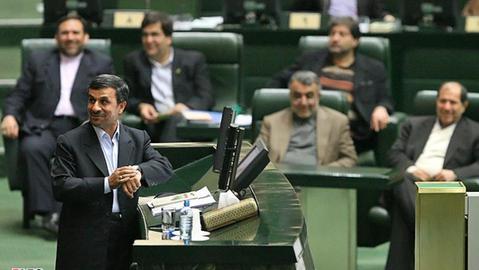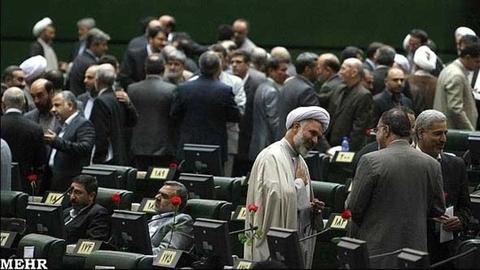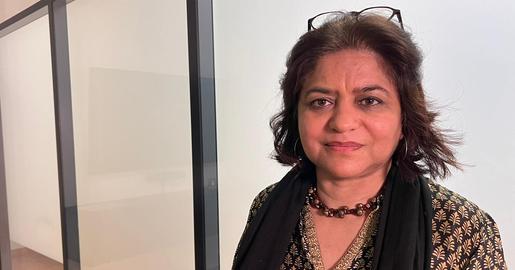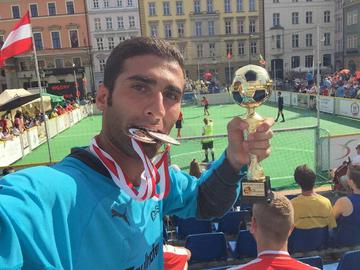The Iranian parliament’s Research Center has analyzed studies into corruption in the Islamic Republic over a 30-year period, looking at how corruption, and studies into it, have grown over the years.
The center examined 305 scholarly studies of corruption over three decades.
The research [Persian link] classifies the studies under the three categories: “Factors causing corruption,” “the consequences of corruption” and “ways to prevent and fight corruption.”
The analysis also examined the frequency of studies on corruption year by year.
In 1989, the first year the study examines, there was only one article dealing with corruption across Iran’s academic journals. This paucity was repeated in 1970 and 1975. In fact, there were no studies on corruption between 1991 and 1995 at all. In 1997, the last year of Akbar Hashemi Rafsanjani’s presidency, the number of studies was only two.
This trend continued until 2001, when President Mohammad Khatami finished his first term. In that year, there were three on studies on corruption. The first hike in the number of articles occurred in 2003, when there were six such studies published. In 2005, the last year of Khatami’s presidency, it reached 14.
The presidency of Mahmoud Ahmadinejad, from 2005 to 2013, saw a significant jump in the number of studies into corruption. Over that period, Iranian analysts and academics published about 160 studies focusing on corruption. This is not surprising given that many analysts and a number of government officials agree that Ahmadinejad’s administration was the most corrupt in the history of the Islamic Republic.
From 2013 to 2017, during President Hassan Rouhani’s first term, approximately 110 studies on corruption were published, 46 of which came out in 2017. The total number of articles published between 2011 and 2017 was 208, meaning that more than 68 percent of the total studies on corruption have been published since 2011.
Turning to the academic disciplines these studies assessed, the center found that out of 305 pieces of research considered, 68 of them, or 22.3 percent, related to political science, and 66, or 21.6 percent, were published by economics scholars. The fact that there is a high percentage of published articles on corruption linked to political science and economics — as opposed to very diverse fields such as accounting, history, Islamic jurisprudence, law, and so on — suggests that these two areas have been instrumental in the spread of corruption.
One of the significant features of the research center’s analysis is the extraction of 1,600 findings from 350 studies. Under the category of “factors causing corruption,” there were about 650 findings; the “consequences of corruption” classification brought up about 250 pieces of work, and there were 750 papers referring to “ways to prevent and fight corruption.”
1. Factors Causing Corruption
Out of the 650 findings in this classification, the center’s analysis broke the research down to 54 smaller categories. The largest numbers of research papers mainly focused on political, legal, economic and cultural themes.
1.1. Political Factors: This area of the center’s investigation looked at studies addressing the political context of corruption in Iran over the last 30 years. It lists the most important factors as follows:
- Power structure and power of monopolies
- Lack of political will to fight corruption
- The government’s effectiveness
- The state of political freedom
- The weakness of accountability
- The state of political parties and political rivalries
1.2. Legal Factors: This category classifies the most important factors behind the spread of corruption over the decades as follows:
- The inflated number of laws and regulations
- Laws and regulations’ lack of transparency
- Deficiency in necessary laws and regulations
- The state of the Judiciary
- The state of law enforcement
- The weakness in oversight
1.3. Economic Factors: Over the last 30 years economic factors have played a significant role in the spread of corruption in the Islamic Republic. The most significant contributors are:
- The state of the economy as a whole
- The role of monopolies
- State control of the economy and lack of competition
- The state of salaries and wages and disruptions in payments
- Lack of transparency, discrimination, inequality in income and class divisions
- Monetary, banking and foreign exchange rate policies
- Rentiers and sinecurism in the government [individuals employed in office jobs that require little or no work, but whose office generates an income]
1.4. Cultural Factors: For many people, this category is perhaps more tangible and accessible than others because it studies the factors that cause corruption from the angle of individuals and their social relations. The most important factors in this category are:
- The value system of the society
- Normalization of corruption and the weakness of inner moral controls
- Spread of materialism
- A tribal approach that puts relationships above principles
2. Consequences of Corruption
In its review of 305 studies, the parliament’s Research Center extracted 250 findings in 21 categories. Most of this research analyzed economic, political, cultural and legal factors.
2.1. Economic Consequences: The most important economic consequences of corruption in Iran over the last 30 years have been:
- The impact on the government’s revenues, expenses and the make-up of its expenditure
- The impact on development and growth
- The impact on investment
- The impact on poverty and financial justice
- Distorting resources and talents
2.2. Political Consequences: Analysis of 305 studies reveals that the most important political consequences of corruption in Iran over the last 30 years have been:
- The impact on the legitimacy and the structure of the political system
- The impact on political stability
- The impact on Iran's international standing
- The impact on the performance and effectiveness of the government
- The impact on the media and the press
- The impact on the performance of government agencies
2.3. Cultural Consequences: The most important consequences in this category have been:
- The impact on moral and religious values
- The impact on social values
- The impact on personal values
2.4: Legal Consequences:
- The impact on laws and regulations
- The impact on crimes and misdemeanors
- The impact on the rights of the society and the government
Ways to Prevent and Fight Corruption
The parliament’s Research Center study presents 50 conclusions in legal, political, economic and cultural areas that can help prevent or fight corruption.
The report concludes that preventing corruption in the field of economics requires transparency, access to information, a break up of monopolies and promoting competition. In politics, the report concludes that there is a need for structural reforms, distribution of power and more accountability to the public. When it comes to legal matters, reforming laws and regulations, transparency, removing ambiguities in laws and regulations and a critical examination of the laws and the legislative process are offered as ways to prevent corruption.
Related Coverage:
Iran’s Corruption Leaks: Shadowy Corrupt Clerics and Sex Scandals, July 6, 2019
How the Corruption Mafia Took $30 Billion out of Iran in One Year, May 28, 2019
Petrochemical Corruption Scandal Grips the Nation, March 11, 2019
Corruption in Iran and the Fishermen Who Lose Out, March 4, 2019
Iran’s Medicine Shortage: More About Corruption and Mismanagement Than Sanctions, September 7, 2018
Corruption is Here — Get Used to It, July 26, 2018
Is Iran Becoming More Corrupt?, March 12, 2018
Currency Plummets as Corruption and Incompetence Continues, April 18, 2018
Iran’s Latest Corruption Scandal: Who’s to Blame?, October 25, 2016
Journalist Arrested After Reporting on Corruption, September 19, 2016


























comments